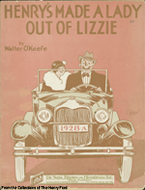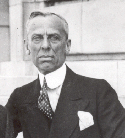
Introduction
The Utilitarian Vision of Henry Ford
General Motors Style Overtakes Ford Efficiency
The Changing American Character
The Struggle for Styling in the Early Industry
The Depression Era Battle for Streamlining
The Triumph of Stylists in the 1950s
Contradictions of Fantastic Styling and the Stylists' Fall From Grace
Stylists Fight Back with "AERO"
Postindustrial Lifestyle Cars & The New Balance of Power Between Engineers and Designers
Complete Text Printable View
Henry's Made a Lady out of Lizzie
Tough Guys and Pretty Boys:
The Cultural Antagonisms of Engineering and Aesthetics in Automotive History
General Motors Style Overtakes Ford Efficiency
Ford's market dominance gave the competition fits, especially General Motors, which was a distant second in sales. In 1920 Pierre DuPont took over this sprawling, disorganized conglomerate of auto firms assembled by Billy Durant in his attempt to create an industry-dominating trust. DuPont appointed to run the reorganized firm a brilliant young manager, Alfred Sloan, whose first task was to devise a strategy to crack Ford's lock on the market. He quickly ruled out head-on price competition, concluding that a capital fund the size of the U.S. Treasury would be required to do so. Sloan decided that GM should offer not cheaper cars but better quality cars in a greater variety. He based this decision on the presumption that consumers with rising incomes who were buying a replacement for their first car wanted something beyond basic transportation. But just what did "better quality" mean? This question would be answered only after the first major battle between engineering and aesthetics.
GM's engineering staff at this time was led by the legendary Charles Kettering, inventor of the electric starter, the high-compression V-8 engine, and lead gasoline additives, the latter of which subsequently proved to be a dangerous pollutant. He and his engineers defined better quality in a utilitarian way, as improved performance and economy. In the early 1920s they were working on an innovative air-cooled engine that GM planned to incorporate into the 1923 Chevrolet in order to make it competitive with Ford's Model T. It was called the "copper-cooled engine" because of the copper fins on the block for dispersing heat. But the engine was delayed due to technical problems, and Sloan grew impatient, declaring that this "engineering dream" undermined the "commercial-mindedness of our strategic plan." In other words, the goal of perfecting the functioning of the car was cutting into profits. He ordered development of the air-cooled engine sidetracked, deciding instead to offer in 1923 a Chevrolet with nine-year-old-technology but a new body of the latest style. This gave the mass-produced car the look of an expensive craftbuilt luxury car, with a lower roof, higher hood, and more rounded lines. Brisk sales of the new-looking Chevrolet convinced Sloan that to compete with Ford it was not necessary to lead in engineering, but merely to offer consumers better looking cars with more variety. As a result, there emerged an expression among the engineers at GM: "Whatever you do, don't let GM do it first." Technical innovation was expensive and unpredictable; the best ideas required long development and could ultimately prove infeasible. Aesthetic innovation--changing the cosmetic look of the car--was relatively cheap and predictable.
Sloan also decided to rely on aesthetics to differentiate GM’s five brands in a clear price hierarchy covering the entire automotive market. He slowly integrated the previously independent brands of Chevrolet, Pontiac, Oldsmobile, Buick, and Cadillac into a scheme of parts-sharing, which cheapened production by increasing the economies of scale on which mass production relied. The different models and makes shared not merely mechanical parts, like transmissions and brakes, but also the structural foundations of the body, called body shells. The dozens of different GM models were all built on three shells of different sizes. The same shell was made to look different, however, by the addition of superficial features like fenders, headlights, taillights, and chrome trim that were unique to each model. GM also added cheap, superficial variety in its mass-produced cars by developing in 1923 a nitrocellulose lacquer paint called Duco, which combined the broad color range of lacquers with the quick drying time of enamel. Ford’s basic black cars were thus eclipsed by GM’s dazzling variety of brightly colored models. In the mid-1920s Sloan also introduced the annual model change, which similarly relied on aesthetics. Every year the body style of all GM cars was changed slightly to give consumers the look of newness and progress. However, underneath the dazzling new surfaces, the body shells and mechanical parts remained unchanged, often for decades. These policies focused on automotive style were responsible for propelling GM sales past Ford in 1927, when the Model T was discontinued due to plummeting sales. To compete with GM's more stylish cars, Ford was forced to introduce in this year the Model A, whose styling also borrowed the look of the luxury classics and inspired a popular song entitled “Henry’s Made a Lady out of Lizzie.”
<<Previous Section - Next Section>>
©2004 Automobile in American Life and Society



